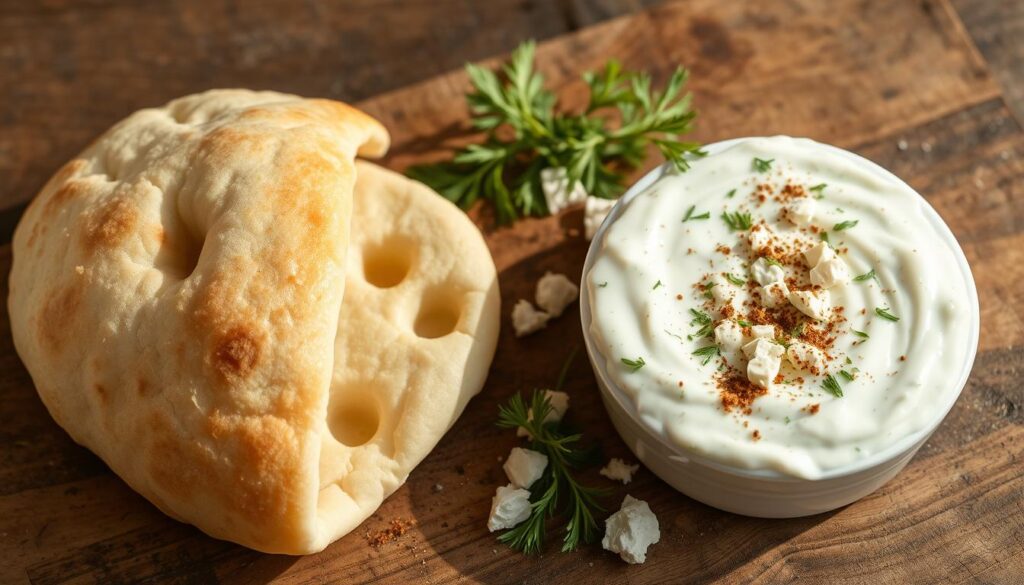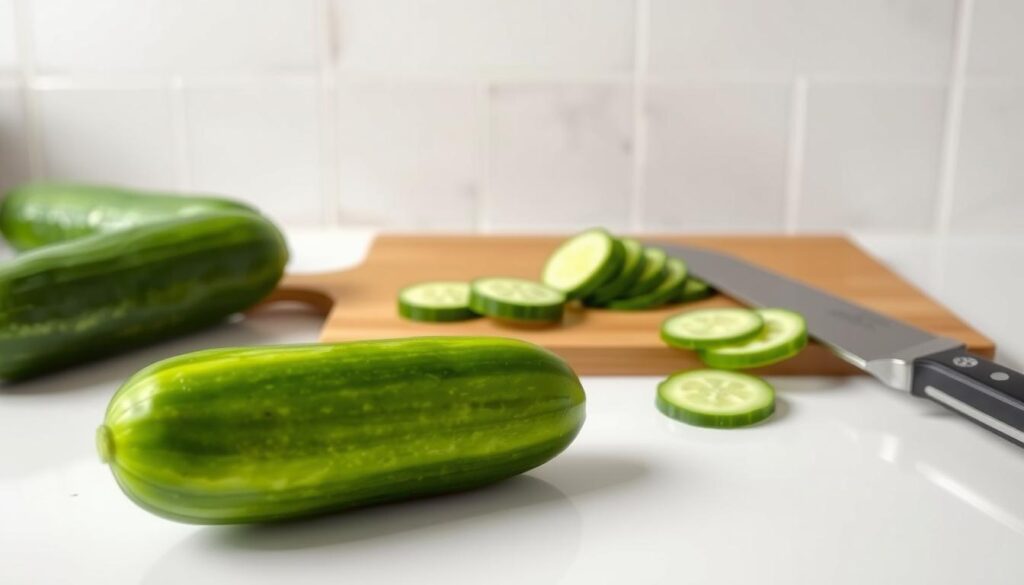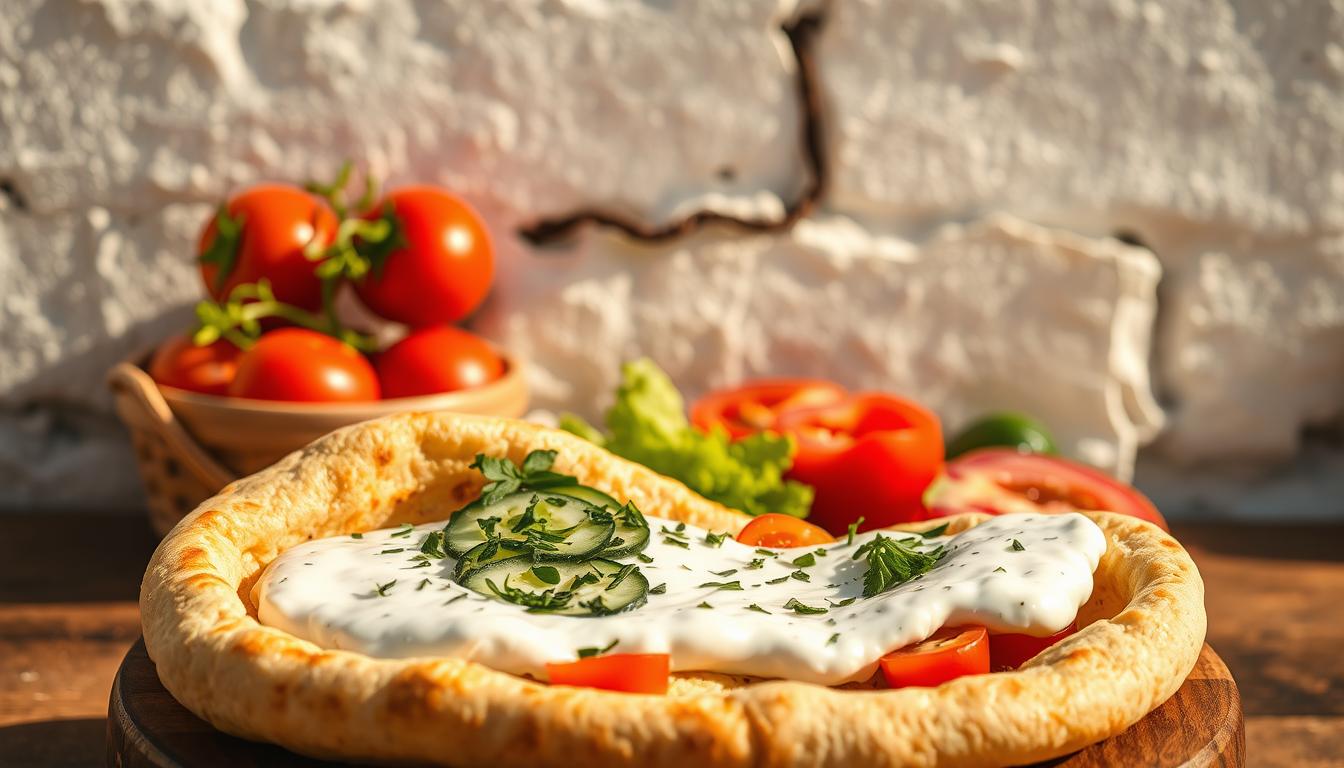Have you ever wondered what makes Mediterranean dishes so tasty? It’s often the mix of flavors and textures. This is especially true for the refreshing tzatziki sauce and the soft pita pocket.
If you’ve dived into Mediterranean cuisine, you know it’s both healthy and delicious. Tzatziki sauce and a pita pocket are a treat for your taste buds. They also make for a quick and nutritious meal.
Key Takeaways
- Discover easy ways to upgrade your tzatziki game.
- Learn how to make the most of your pita pockets.
- Explore the benefits of Mediterranean dishes for healthy eating.
- Find inspiration for quick and nutritious meals.
- Enhance your culinary skills with simple tzatziki recipes.
The Perfect Mediterranean Duo: Understanding Tzatziki and Pita Pockets
Learning how tzatziki and pita pockets work together is key to enjoying Mediterranean food. Tzatziki is a cool sauce made from yogurt, cucumbers, and spices. It’s been a favorite in Mediterranean cooking for ages.
Traditional Tzatziki: Origins and Basic Components
Tzatziki comes from Greece, where it’s loved with many dishes. It’s made with yogurt, cucumbers, garlic, lemon juice, and dill. Its simple ingredients create a refreshing and flavorful sauce.
To make traditional tzatziki, you strain yogurt, chop cucumbers, and mix them with garlic, lemon, and dill. This makes a creamy, tangy sauce that goes well with many foods.
Why Tzatziki and Pita Pockets Are a Culinary Match
Tzatziki and pita pockets are a perfect pair. The soft pita bread is a great match for the cool tzatziki. Together, they create a delicious balance that makes meals better.
| Component | Tzatziki | Pita Pockets |
|---|---|---|
| Texture | Creamy, Refreshing | Soft, Fluffy |
| Flavor | Tangy, Garlicky | Mild, Slightly Yeasty |
| Role in Dish | Condiment, Flavor Enhancer | Base, Wrapper |
Essential Base Recipe: Your Tzatziki Foundation
To start your tzatziki, use 1 cup of strained yogurt, 1/2 cup of grated cucumber, 1 minced garlic clove, 1 tablespoon of lemon juice, and 1 tablespoon of chopped fresh dill. Mix well and add salt to taste.
Try different versions of this recipe by changing the garlic or adding herbs. This way, you can find your favorite tzatziki flavor.

Mastering tzatziki can make your Mediterranean dishes even better. Enjoy the perfect mix of this cool sauce and the warm pita pockets.
1. Select Premium Yogurt for a Superior Base
The quality of yogurt is key to making great tzatziki. Greek yogurt is top-notch because it’s full of protein, probiotics, and more. It’s a healthy choice for tzatziki.
You have several yogurt options: Greek, labneh, and regular. Each affects the taste and texture of your tzatziki differently.
Choosing Between Greek, Labneh, and Regular Yogurt
Greek yogurt is creamy and thick, thanks to straining. Labneh is even creamier, strained more. Regular yogurt might make tzatziki thinner unless strained.
- Greek Yogurt: High in protein, thick, and creamy.
- Labneh: Thicker and creamier than Greek yogurt, with a rich texture.
- Regular Yogurt: Thinner and may require straining to achieve desired consistency.
How to Strain Yogurt for Thicker, Creamier Tzatziki
To strain yogurt, use cheesecloth or a fine-mesh sieve. Put yogurt in it over a bowl. Refrigerate for hours or overnight.
Straining thickens the yogurt and makes it taste richer. Choosing and preparing your yogurt well makes your tzatziki better.
2. Master Cucumber Preparation for Optimal Texture
Getting the perfect tzatziki starts with how you prepare the cucumber. This step is key for the right texture. The cucumber adds coolness and crunch that goes well with the creamy yogurt.
To do it right, pick the right cucumber, prepare it well, and remove extra moisture.
English vs. Persian Cucumbers: Making the Right Selection
English cucumbers are often chosen for tzatziki because they’re long, skinny, and have fewer seeds. They’re less watery and easier to work with. But, Persian cucumbers are also good, offering a similar taste and texture.
Look for cucumbers that are firm and bright green for the best results.

Grating vs. Dicing: How Each Method Affects Your Tzatziki
The way you prepare your cucumber changes the tzatziki’s texture. Grating makes it finer, blending well with yogurt for a smooth sauce. Dicing gives a chunkier texture, adding a nice contrast.
Think about the texture you want when choosing between grating and dicing.
Salt-Drawing Technique for Removing Excess Moisture
Removing extra moisture from cucumbers is key to a thick tzatziki. The salt-drawing method is great for this. Sprinkle salt on grated or diced cucumber, let it sit, then squeeze out the liquid.
This ensures your tzatziki stays creamy and thick.
3. Transform Your Tzatziki with Garlic Infusion Methods
To elevate your tzatziki, try garlic infusion. It adds depth and richness, turning it into a complex condiment. The flavor changes based on whether you use raw or roasted garlic.
Raw vs. Roasted: Creating Different Flavor Intensities
Choosing between raw or roasted garlic affects your tzatziki’s taste. Raw garlic is sharp and pungent, while roasted garlic is sweet and nutty. Try both to find your favorite.
- Raw garlic: Use for a bold, pungent flavor.
- Roasted garlic: Ideal for a mellow, rich flavor.
How to Prepare Garlic Confit for Mellow, Rich Flavor
Garlic confit adds a deep, mellow flavor to tzatziki. Cook garlic cloves in oil until soft and fragrant. This method softens the garlic, making it creamy and rich.
| Garlic Preparation Method | Flavor Profile | Best Use |
|---|---|---|
| Raw Garlic | Pungent, Sharp | For those who enjoy a strong garlic flavor |
| Roasted Garlic | Mellow, Sweet, Nutty | Ideal for a subtle garlic taste |
| Garlic Confit | Deep, Rich, Creamy | Perfect for adding complexity to tzatziki |
Adding garlic infusion to your tzatziki recipe boosts its flavor. It makes your pita pocket more interesting and dynamic.
4. Experiment with Herb Variations Beyond Traditional Dill
Try new herbs to make your tzatziki better. Dill is classic, but other herbs can add exciting flavors. This makes your tzatziki more interesting.
The Mediterranean has many herbs that go well with dill. Mixing them can create unique tastes. It’s fun to try different combinations.
Mediterranean Herb Combinations That Elevate Tzatziki
Using herbs together can make your tzatziki taste better. For example, dill with parsley and mint is refreshing. Or, try oregano and thyme for a deeper flavor.
- Dill and Parsley: A classic mix that’s fresh and traditional.
- Mint and Dill: It’s cool and perfect for a dip.
- Oregano and Thyme: It’s earthy and contrasts well with creamy tzatziki.
Fresh vs. Dried Herbs: Application Techniques and Timing
Choosing between fresh and dried herbs depends on when you make your tzatziki. Fresh herbs are lively and best added just before serving.
Dried herbs have a stronger taste and can be added earlier. This lets their flavors mix well with the yogurt and other ingredients.
| Herb Type | Flavor Profile | Best Used |
|---|---|---|
| Fresh Herbs | Vibrant, Fresh | Just before serving |
| Dried Herbs | Concentrated, Earthy | During preparation |
Trying different herbs can really improve your tzatziki. It makes your Mediterranean dishes stand out.
5. Perfect Your Acid Balance with Citrus and Vinegar
A great tzatziki needs the right mix of ingredients, especially the acids. Getting the acid balance just right is key. It makes the sauce tangy and refreshing, perfect for your pita pockets.
Adding citrus or special vinegars can boost your tzatziki’s flavor. The acidity brightens the dish and balances the richness of the yogurt and other ingredients.
Citrus Options: How to Incorporate Lemon, Lime, and Zests
Lemons and limes add a tangy taste to tzatziki. Lemon juice is a favorite for its acidity and taste. You can use the juice or zest of citrus fruits in your tzatziki.
- Lemon: Adds a classic, bright acidity.
- Lime: Provides a slightly different, more pronounced citrus flavor.
- Zest: Incorporating citrus zest can add a nice aromatic flavor.
Specialty Vinegars: Selecting and Adding for Unique Profiles
Other than citrus, different vinegars can also balance the acid. Vinegars like apple cider or white wine vinegar can give your tzatziki a unique taste.
Think about the flavor you want when picking a vinegar. Apple cider vinegar is fruity and a bit sweet. White wine vinegar is sharper.
Try out different citrus and vinegars to find the perfect balance for your taste. This will take your tzatziki to the next level.
The Ultimate Pita Pocket: Pairing Upgraded Tzatziki with Fresh Fillings
Take your Mediterranean meal to the next level by adding the perfect fillings to your upgraded tzatziki in a pita pocket. The secret to a great pita pocket is finding the right mix of ingredients. You want to balance your tzatziki with items that add texture, flavor, and freshness.
Complementary Protein Options for Tzatziki Pita Pockets
There are many protein options that go well with tzatziki in a pita pocket. Grilled chicken is a favorite, marinated in olive oil, lemon juice, and herbs. Lamb seasoned with Mediterranean spices and beef with garlic and paprika are also great choices.
For a leaner option, try grilled salmon or tilapia with a zesty lemon-herb marinade. Vegetarians can enjoy falafel or grilled halloumi cheese for a tasty twist.
Vegetable Combinations That Enhance Your Tzatziki Experience
Vegetables are key to making your pita pocket better. A mix of crisp lettuce, juicy tomatoes, and thinly sliced red onions adds freshness. You can also add roasted vegetables like bell peppers and zucchini for a smoky taste.
Other great choices include pickled cucumbers or pickled turnips for a tangy flavor. Fresh mint and parsley add an herbaceous note. The goal is to balance the cool tzatziki with the warmth and variety of vegetables and proteins.
6. Select and Use Quality Olive Oils for Richness
Take your tzatziki to the next level with top-notch olive oil. This key ingredient in Mediterranean cooking brings a richness and depth that’s unmatched by others.
Olive oil is more than just a finishing touch. It’s a crucial element that boosts your tzatziki’s flavor. When picking an olive oil, think about its region. Each area has its own unique taste.
Regional Olive Oil Characteristics and Pairing Principles
Every region has its own olive oil style. Greek oils are bold and peppery, perfect for traditional tzatziki. Italian oils are smoother and fruitier, great for a lighter tzatziki.
Match your olive oil with your tzatziki’s flavors. A strong oil works well with bold garlic and herbs. A milder oil is better for a fresher tzatziki.
Creating and Using Infused Oils for Added Dimension
Infused oils bring a new level of flavor to your tzatziki. By mixing olive oil with herbs or spices, you get unique tastes. For example, chili-infused oil adds spice, while herb-infused oil boosts freshness.
To make infused oil, mix your chosen ingredients with olive oil in a clean jar. Let it steep for a few days. Then, strain the oil and use it in your tzatziki.
Choosing and using quality olive oils makes your tzatziki rich and memorable. It’s a key part of your Mediterranean meals.
7. Add Spices for Heat and Complexity
Spices can make your tzatziki more interesting. They add depth, heat, and a unique twist. This turns a simple dip into a complex dish.
Mediterranean Spice Blends: Za’atar, Sumac, and Aleppo Pepper
Mediterranean spice blends add complexity to tzatziki. Za’atar brings earthy, herbal notes. Sumac adds a tangy, slightly sour taste.
Aleppo pepper adds mild heat with fruity undertones. It warms the dish without overpowering it.
To use these blends, start with a small amount. Taste as you go. This way, you can adjust the seasoning to your liking.
Chili Options: From Mild Paprika to Spicy Harissa
For those who like a bit of heat, chili options are great. Paprika adds smoky sweetness. Harissa brings a bold, spicy kick.
- Paprika: Adds a smoky, slightly sweet flavor.
- Harissa: Introduces a spicy, bold flavor.
- Chili powder: Can add a variable level of heat depending on the type used.
Toasting Spices to Release Maximum Flavor
Toasting spices enhances their flavor. Gently heating them in a dry pan releases their essential oils. This makes their flavors more pronounced and aromatic.
To toast spices, place them in a dry pan over low heat. Stir frequently until fragrant. Let them cool before grinding or using in your tzatziki. This step can make your dish more complex and engaging.
8. Incorporate Texture Enhancers for Gourmet Appeal
Texture enhancers can turn your tzatziki into a gourmet treat. Adding nuts and seeds brings depth and complexity to this classic sauce.
Toasting and Adding Nuts
Nuts add a satisfying crunch to your tzatziki. Pine nuts, walnuts, and pistachios are great choices. Toasting them before adding enhances their flavor and texture.
Spread the nuts on a baking sheet and toast in a 350°F oven for 5-7 minutes. They should be fragrant and lightly browned.
Start with a small amount of nuts and taste as you go. This lets you adjust the amount to your liking. It also ensures the nuts blend well with the other flavors.
Seed Options
Seeds are also excellent for adding texture to tzatziki. Sesame seeds, poppy seeds, and sunflower seeds offer unique textures and flavors. Sesame seeds have a nutty taste and can be used raw or toasted.
Poppy seeds add a subtle crunch and a slight nutty taste. Sunflower seeds provide a more pronounced texture and a slightly bitter flavor. This balances the richness of the yogurt.
To add seeds, mix them in directly or toast them lightly first. Toasting seeds in a dry pan over medium heat brings out their flavors. Stir frequently until fragrant.
9. Surprise Your Palate with Unexpected Add-ins
Take your tzatziki to the next level with unexpected add-ins. These new ingredients can turn a classic dish into something truly special. It’s a way to make your taste buds do a happy dance.
Roasted Vegetable Additions
Roasted vegetables can add a lot of flavor and texture to your tzatziki. Try adding roasted eggplant, red pepper, or garlic for a smoky twist. These ingredients make your dip more interesting and complex.
- Roasted eggplant adds a meaty texture and a hint of smokiness.
- Red peppers bring a sweet and slightly charred flavor.
- Roasted garlic mellows out the pungency of raw garlic, adding a rich depth.
Sweet Elements
Sweet elements can balance out the tanginess of tzatziki. Add pomegranate seeds for a burst of juicy sweetness or fig jam for a rich, fruity flavor. A drizzle of honey can also add a touch of warmth and sweetness.
- Pomegranate seeds provide a fruity and refreshing contrast.
- Fig jam adds a sweet and savory element.
- Honey contributes a floral and soothing quality.
Cheese Incorporations
Adding different types of cheese can make your tzatziki creamier and richer. Feta is a classic choice, but you can also try goat cheese for a tangier taste or labneh for an even creamier texture.
- Feta cheese is traditional and adds a salty, crumbly texture.
- Goat cheese introduces a tangy and creamy element.
- Labneh enhances the overall creaminess and can add a subtle tang.
By adding these unexpected ingredients, you can make a tzatziki that’s not only delicious but also unique and exciting. Don’t be afraid to try different combinations to find your perfect blend.
10. Master Presentation Techniques for Restaurant-Quality Results
To make your tzatziki stand out, focus on how it looks. A good presentation can make your dish unforgettable. It’s all about making your food visually appealing.
Plating and Garnishing Ideas for Visual Appeal
Plating and garnishing are key to a great-looking tzatziki. Choose the right dish first. A shallow bowl or a plate with a slight depression is perfect. Add fresh herbs like dill, parsley, or mint for color and freshness.
- Put a dollop of tzatziki in the center and surround it with pita bread or veggies.
- Add a sprinkle of paprika or sumac for color and Mediterranean flavor.
- Arrange toppings or fillings in a pattern for visual interest.
Think about your dish’s color palette. Balance reds with greens or whites. For example, red pepper goes well with green herbs or white sesame seeds.
Temperature and Timing: Serving Tzatziki at Its Best
Serving tzatziki chilled is best for its flavor and texture. But don’t serve it frozen, as it can lose flavor.
| Serving Temperature | Effect on Tzatziki |
|---|---|
| Chilled (Refrigerated) | Preserves flavor and texture, ideal for serving. |
| Room Temperature | May lose some freshness and texture. |
| Frozen | Flavors are muted, and texture becomes unappealing. |
Timing is key. Make your tzatziki just before serving for the best taste. If you make it ahead, store it in an airtight container in the fridge. Stir well before serving.
By mastering these presentation techniques, you can elevate your tzatziki game. Create a memorable dining experience for your guests.
From Basic to Brilliant: Taking Your Mediterranean Meals to the Next Level
You now have the tools to make your Mediterranean meals amazing. By using the tips and techniques shared, you can enjoy healthier, tastier dishes. Focus on fresh ingredients and simple cooking to make your meals delicious.
Try new ingredients and recipes to find exciting flavors and textures. Whether it’s a quick dinner or a big gathering, your meals will wow everyone. Tzatziki and pita pockets are great for trying different fillings and toppings, making each meal special.
Keep improving your cooking skills. Mediterranean cooking is all about simplicity and freshness. By following these principles, you can make meals that nourish and bring people together, showing the value of healthy eating.

